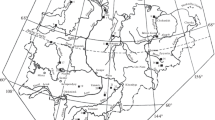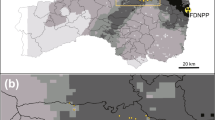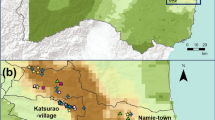Abstract
The european lynx (Lynx lynx) might be expected to have a high intake of radiocaesium in the parts of Sweden where the main prey of the lynx, namely reindeer and roe deer have high activity concentrations of radiocaesium because of high ground deposition. We have measured 137Cs in muscle samples from 733 lynx during 1996–2003. The aim was to quantify the extent to which radiocaesium is transferred from fallout deposition to lynx, to test whether the transfer was higher in areas where there are reindeer present, to see if there was any decline in radiocaesium over time, and to calculate the radiation dose to lynx. Most samples were collected in central and northern Sweden during January–April. Activity concentrations in lynx varied from 13 Bq kg−1 to about 15 kBq kg−1 fresh weight, with the highest value corresponding to a radiation dose at 18 mGy/year. Aggregated transfer coefficients (Tag), calculated by dividing the 137Cs activity concentration in lynx muscle by the average ground deposition (total from Chernobyl and nuclear weapon tests) within a 50 km radius around the location of the lynx, varied from 0.004 to 1.3 m2 kg−1 and were significantly higher within the reindeer herding area than outside. The concentration ratio (CR) for lynx/reindeer was 2.6 on average, whilst the average for lynx/roe deer outside the reindeer herding area was lower at 1.3. Based on these results, a CR of around 2 could be considered representative for the general ratio between predator and prey. A long-term decline of radiocaesium in prey species was reflected in lynx, with an effective half-life of 7 years from 1996 to 2003. The study shows that the accumulation of radiocaesium in predators, especially predators of reindeer, makes them more vulnerable to high radiocaesium deposition than most other wild species.




Similar content being viewed by others
References
Sunde P, Kvam T (1997) Diet pattern of Eurasian lynx Lynx lynx: what causes sexually determined prey size segregation? Acta Theriol 42:189–201
Pedersen VA, Linnell JDC, Andersen R, Andrén H, Lindén M, Segerström P (1999) Winter lynx Lynx lynx predation on semi-domestic reindeer Rangifer tarandus in northern Sweden. Wildl Biol 5:203–211
Sunde P, Kvam T, Bolstad JP, Bronndal M (2000) Foraging lynxes in a managed boreal-alpine environment. Ecography 23:291–298
Molinari-Jobin A, Molinari P, Breitenmoser-Würsten C, Breitenmoser U (2002) Significance of lynx Lynx lynx predation for roe deer Capreolus capreolus and chamois Rupicapra rupicapra mortality in the Swiss Jura Mountains. Wildl Bio. 8:109–115
Andrén H, Liberg O, Ahlqvist P, Danell A (2001) Fler lodjur—färre rådjur (“More lynx less roe deer”) (in Swedish). Svensk Jakt 139:264–267
Linnell JDC, Andersen R, Kvam T, Andren H, Lidberg O, Odden J, Moa PF (2001) Home range size and choice of management strategy for lynx in Scandinavia. Environ Manage 27:869–879
Avila R, Johanson KJ, Bergström R (1999) Model of the seasonal variations of fungi ingestion and137Cs activity concentrations in roe deer. J Environ Radioact 46:99–112
Åhman B, Åhman G (1994) Radiocesium in Swedish reindeer after the Chernobyl fallout: seasonal variations and long-term decline. Health Phys 66:503–512
Lönnberg E (1930) Lodjurets förekomst i Sverige de sista hundra åren (“Lynx in Sweden during the last one hundred years”) (in Swedish). K. Svenska Vetenskapsakademiens Skrifter i Naturskyddsärenden Nr. 14
Swedish Environmental Protection Agency (2003) Beslut om skyddsjakt efter lodjur vintern 2003/2004 (“Decision about culling of lynx for the winter 2003–2004”) (in Swedish). Swedish Environmental Protection Agency, Stockholm
Andrén H, Linnell JDC, Liberg O et al. (2002) Estimating total lynx Lynx lynx population size from censuses of family groups. Wildl Biol 8:299–306
Wright SM, Howard BJ, Strand P, Nylén T, Sickel MAK (1999) Prediction of137Cs deposition from atmospheric nuclear weapons tests within the Arctic. Environ Pollut 104:131–143
Åhman B (1999) Direct monitoring of radiocaesium in live reindeer and reindeer carcasses. In: Søgaard-Hansen J, Damkjaer A (eds) Nordic Society for Radiation Protection, Proceedings of the 12th ordinary meeting, Skagen, Denmark, 23–27 August 1999. Risø National Laboratory, Roskilde, pp 159–162
Falk R, Eklund G, Giertz H, Östergren I (1991) Cesium in the Swedish population after Chernobyl: internal radiation, whole-body counting. In: Moberg L (ed) The Chernobyl fallout in Sweden. Results from a research programme on environmental radiology. Swedish Radiation Protection Institute, Stockholm, pp 547–577
Yamagata N (1962) The concentration of common cesium and rubidium in human body. J Radiat Res 3:9–30
Hanson WC, Watson DG, Perkins RW (1967) Concentration and retention of fallout radionuclides in Alaskan arctic ecosystems. In: Åberg B, Hungate FP (eds) Radioecological concentration processes. Proceedings of an International Symposium held in Stockholm 25–29 April, 1966. Pergamon Press, Oxford, pp 233–245
Gaare E, Staaland H (1994) Pathways of fallout radiocaesium via reindeer to man. In: Dahlgaard H (ed) Nordic Radioecology. The transfer of radionuclides through nordic ecosystems to man. Elsevier, Amsterdam, pp 303–334
Åhman B, Wright SM, Howard BJ (2001) Effect of origin of radiocaesium on the transfer from fallout to reindeer meat. Sci Total Environ 278:171–181
Johanson KJ (1994) Radiocaesium in game animals in the Nordic countries. In: Dahlgaard H (ed) Nordic radioecology. The transfer of radionuclides through nordic ecosystems to man. Elsevier, Amsterdam, pp 287–302
Kiefer P, Pröhl G, Müller H, Lidner G, Drissner J, Zibold G (1996) Factors affecting the transfer of radiocaesium from soil to roe deer in forest ecosystems of southern Germany. Sci Total Environ 192:49–61
Bjärvall A, Franzén R, Nordkvist M, Åhman G (1990) Renar och rovdjur. Rovdjurens effekter på rennäringen (“Reindeer and predators. The effects of predators on reindeer husbandry”) (in Swedish). Naturvårdsverket Förlag, Stockholm
Pendleton RC, Lloyd RD, Mays CW, Church BW (1964) Trophic level effect on the accumulation of cesium-137 in cougars feeding on mule deer. Nature 204:708–709
Lowe VPW, Horrill AD (1991) Caesium concentration factors in wild herbivores and the fox (Vulpes vulpes L.). Environ Pollut 70:93–107
Ekman L, Greitz U (1967) Distribution of radiocesium in reindeer. In: Åberg B, Hungate FP (eds) Radioecological concentration processes. Proceedings of an International Symposium held in Stockholm 25--29 April, 1966. Pergamon Press, Oxford, pp 655–661
Rissanen K, Rahola T, Aro P (1990) Distribution of cesium-137 in reindeer. Rangifer 10:57–66
Åhman B (1994) Body burden and distribution of137Cs in reindeer. Rangifer 14:23–28
Green RM, McNeill KG, Robinson GA (1961) The distribution of potassium and caesium-137 in the calf and the pig. Can J Biochem Physiol 39:1021–1026
Andersson I, Hansson I (1989) Distribution of137Cs to different muscles and internal organs of lambs fed contaminated hay. Swedish J Agric Res 19:93–98
UNSCEAR (1996) Sources and effects of ionizing radiation. United Nations Scientific Committee on the Effects of Atomic Radiation. UNSCEAR 1996 Report to the General Assembly, with Scientific Annex. United Nations, New York
Åhman B, Nylén T (1998) Radiocaesium in reindeer in relation to ground deposition, levels in vegetation, season and diet (in Swedish). Progress report to the Swedish Radiation Protection Institute. 1998, Reindeer Husbandry Unit, Swedish University of Agricultural sciences, Uppsala
Acknowledgements
Financial support for this study was obtained from the Swedish Radiation Protection Authority (SSI P 1304.02). Collection and monitoring of samples were supported by the Swedish Environmental Protection Agency. Collaboration by CEH was motivated under the International Union of Radioecology’s Task Force on the Arctic and Antarctic.
Author information
Authors and Affiliations
Corresponding author
Rights and permissions
About this article
Cite this article
Åhman, B., Wright, S.M. & Howard, B.J. Radiocaesium in lynx in relation to ground deposition and diet. Radiat Environ Biophys 43, 119–126 (2004). https://doi.org/10.1007/s00411-004-0242-y
Received:
Accepted:
Published:
Issue Date:
DOI: https://doi.org/10.1007/s00411-004-0242-y




